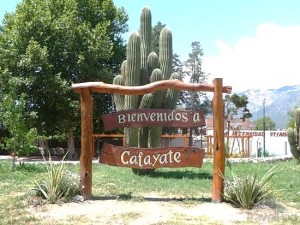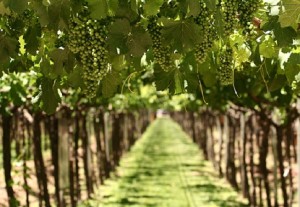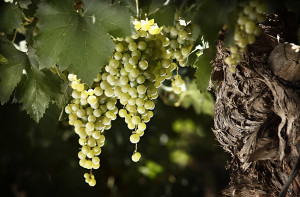Today we have a conference preview from Nora Z. Favelukes and Leslie Gevirtz, who tell us about a fascinating trip they took to Argentina, as well as the Torrontés grape variety and the amazing wines it produces in Argentina.
In March 1987, I found myself in a small car with the son of Arnaldo Etchart, the producer of some amazing, prize-winning wines from Bodegas Etchart. The young man was speeding up over rock formations and roaring through canyons while I held on for my dear life, keeping one eye open just to see the breathtaking scenery. We were heading to the Calchaqui Valley – Salta’s main winemaking area. I was going there to coordinate a visit for the television producer Burt Wolf in advance of a video project of his.
Two-and-a-half-hours later, we arrived at Cafayate, a charming town with cobbled streets, low-rise houses painted white on the outside and topped with red roofs, a main square with the Church on one side and the City Hall on the other – typical of colonial times.
Guided by Jose Luis Mounier, Etchart’s winemaker at the time, I was formally introduced to Torrontés, Salta’s specialty and the favorite white wine of most Argentineans. As we visited vineyards and toured the wineries, I became enamored of this highly aromatic, delicious wine. The highlight of the visit was a 6-years-oak-aged Torrontés, an experiment Jose Luis was working on to evaluate the effects of oak and aging on this grape. I was pleasantly surprised and intrigued.
From then on, I was hooked. I love their intense sweet aromas of jasmine, lychee and stone fruits. The wines have a high acidity; spiciness and they’re dry. It is a tricky wine, Torrontés – it captures you with the sweet aromas of fruit and it awakens your palate with its acidity, powerful flavors, and dry finish.
Truth be told, I really only preferred the ones from Salta for the elegance, the high acidity, and the intensity of the aromas. The Torrontés from the other regions were OK, but nothing to write home about. They were rustic and the bitter notes at the end of the palate were more pronounced. However, things improved during the 1980’s with the modernization of the Argentine wine industry, new vineyard management techniques, and new technology; and the quality of Torrontés improved significantly.
For me, my “Aha!” moment came over five years ago when Alberto Antonini, one of Argentina’s most prominent flying winemakers, introduced the Nieto Senetiner Reserva Torrontés in New York City. It was “Helloooo”.
It had the fruitiness, the acidity, and the complexity that I love in what is a fun wine. So when I tasted it and saw that this wine was from Mendoza, I jumped! I knew that the levels of wine making and vineyard management had hit new heights.
I have also been continually amazed by the techniques that winemakers are mastering. Every year as part of my duties for the Wines of Argentina, I travel with sommeliers to Argentina – and every other year we go to Salta. So over the last eight years I have seen the evolution of this uniquely Argentine varietal. It is a natural crossing of Muscat of Alexandria and Criolla Chica – a grape brought by the Spanish in the 16th century. There are three different clones: the Riojano, Sanjuanino and the Mendocino. Of the three, the Riojano is the most widely planted and produces higher quality wines.
Again as part of my duties, I coordinate a Comprehensive Tasting of Argentine Wines with Stephen Tanzer at the Argentine Consulate in New York. We generally taste 400 wines – and it is what I call a democratic tasting. It is open to all the wineries – big and small. They are all given the same chance to be tasted by Tanzer.
Now, I consider it my duty to taste the wines before Tanzer, just to make sure they are correct. But with some wines, I like to taste a little longer, so to speak. With so many wines, I usually just do it by the aromas. If the nose is good, the wine is good. And, if the aromas are superb I give it my full attention… and that happened with Colomé Torrontés 2014. This one was different. It was good, as it usually is, but something was different from its previous vintage, more interesting in a good way. So, I called the winery to find out what was going on. It seemed that for the first time they were blending Torrontés grapes from two vineyards at different altitudes. And, the effect was very noticeable, the wine was extremely aromatic and at the same time, had a new complexity.
Then last November, I tasted Susana Balbo’s Barrel Fermented Torrontés and I was just floored. I knew then that I had to do a seminar on Torrontes. I have to show, not tell. So, we are going to have the wine in my seminar because I have to teach about this. Torrontes showed me that the stereotype – as being always young and fresh and fruity – was shattered. This is coming from someone who doesn’t usually like wood in white wine. I usually find that the oak overpowers the fruit, but here it does something magical. The oak treatment is so subtle, adding to the elegance a new complexity and texture.
So now that Torrontés has matured, I want to re-introduce and share this evolution with my fellow members of the Society of Wine Educators Conference 2015. It’s almost a revolution.
Nora Z. Favelukes is the founder of QW Wine Experts, an international consulting company based in the United States dedicated to brand building, strategic marketing and public relations of imported fine wines. For the past seven years, QWWE has been responsible for the Wines of Argentina branding account. Nora also teaches on classes on South American and Iberian Peninsula wines at New York City College of Technology, Brooklyn, NY. In 2006, she received the “Outstanding Industry Professional Award” by New York City College of Technology. Nora is also a member of SWE’s Board of Directors.



